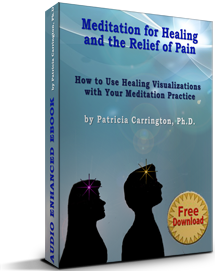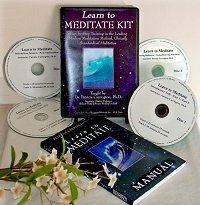Dr. Patricia Carrington's award winning meditation technique CSM (Clinically Standardized Meditation) is a clinically sensitive meditation method developed by the Medical Department of New York Telephone Company and used by numerous medical institutions, organizations, and individuals worldwide. For information .
Is Meditation a Unique State?
How Do Meditation Techniques Differ from One Another?
Patricia Carrington, Ph.D.
Author of “The Book of Meditation”
There are literally hundreds of practices which can be listed under the heading of ‘meditation’. All these have in common the ability to bring about a special kind of free-floating attention where rational thought is bypassed and words are of far less importance than in everyday life. It is characteristic of this state that when in it, the person is completely absorbed by his particular object of meditation. If something else comes to mind, it will usually drift in with a sort of vague, faraway quality, and then drift out again.
The devices used to bring about this state are as diverse as gazing quietly at a candle flame; attending to the mental repetition of a sound (mantra); following one’s own breathing; concentrating on the imagined sound of rainfall; chanting out loud a ritual word or phrase; attending to body sensations; concentrating on an unanswerable riddle (koan); passively witnessing the flow of thoughts through one’s mind; or whirling in a stereotyped dance.
Whatever, the aim is the same: to alter the way the meditator experiences her own existence. All these techniques close out the distractions of the outer world in much the same way as an isolation chamber. In a sensory-deprivation experiment the subject is removed from incoming sense impressions by being placed in a soundproofed room, by wearing goggles to eliminate patterned vision, or by undergoing other sense-reducing manipulations.1 In meditation, the meditator removes his attention from distracting sense impressions and thoughts by creating an inner ‘isolation chamber’ of his own making. It is when the outer world is removed that meditation can take effect and the individual is said to become ‘centered’.
In the meditative traditions the words ‘centered’ and ‘centering’ refer to the restoration of an inner balance accomplished through the use of devices which serve to focus the mind. This process is seen as acting like a psychological gyroscope which stabilizes mind and body and neutralizes the tendency to pull away from the center of one’s being.
Despite the fact that attention is directed toward a meditational ‘object’, however, each technique copes with a basic property of meditation which can best be described as a countertendency, a need to pull away from the object of focus. Even the calm and centered mind is not entirely still. Periodically it reaches for renewed contact with the environment, either through sense impressions or thoughts, and each meditational system has its own way of dealing with this ‘outward stroke’ of meditation.
Some systems are not permissive, or may even be coercive with respect to the handling of ‘distractions of the mind’ during meditation. A non-permissive form of meditation will demand strict concentration on the meditational object. Practitioners will be directed to pinpoint their attention, to banish intruding thoughts from their mind by an act of will, and to return immediately and forcefully to the object of focus whenever they find their attention has wandered. This approach is seen in extreme form in instructions given to a meditator in a fifth century Buddhist treatise dealing with thoughts that may intrude into the meditation:
. . . with teeth clenched and tongue pressed against the gums, he should by means of sheer mental effort hold back, crush and burn out the [offending] thought; in doing so, these evil and unwholesome ideas, bound up with greed, hate or delusion, will be forsaken, then thought will become inwardly calm, composed and concentrated.2
In contrast, many meditative systems use varying degrees of permissiveness toward intruding thoughts. In these more permissive techniques, the meditator is instructed to return gently and without effort to the object of focus.
Although there are no experimental findings dealing with the effects on the meditator of permissive versus non-permissive forms of meditation, it may well make a difference whether the meditator practices one approach or the other. The effects may even be different if he mistakenly interprets his form of meditation as being non-permissive when it is not. Most techniques for meditation require that the meditator make no conscious effort, but ‘let things happen’ rather than make them happen. Often, however, the average person automatically injects coercion into a meditative practice unless carefully trained to do otherwise. The result is roughly the same as it would be if a stern teacher were standing close by and commanding one to ‘shape up’ the whole time one meditates.
A non-permissive approach to meditation (self-produced or produced by instructions from someone else) can increase guilt in the meditator as she begins to blame herself for not meditating ‘correctly’, or for the kinds of intruding thoughts she is having. A permissive approach, on the other hand, because it encourages an accepting attitude toward the thoughts or feelings which may inadvertently arise during meditation, may help the meditator to handle previously unacceptable feelings which she might have been hiding or ‘repressing’. It may also help release emotional tensions, because these have an opportunity to play themselves out in fantasy in this more permissive state.
Right now I can only speculate about the effects on the meditator of different kinds of meditation instruction. There is no experimental evidence which sheds light on the subject. As the study of meditation proceeds, no doubt this will be looked into and a good deal more will be known.
1. Meditation journal of George Edington (personal communication)
2. E. Conze, Buddhist Meditation (New York: Harper, 1969), p. 83.
Leave a Reply
You must be logged in to post a comment.

